Bibliometric Profile of Global Microplastics Research from 2004 to 2019
Abstract
1. Introduction
2. Materials and Methods
2.1. Data Sources
2.2. Data Screening
2.3. Analytical Methods
2.3.1. Basic Bibliometric Analysis Method
2.3.2. Network Analysis Methods
3. Results and Discussion
3.1. Basic Bibliometric Analysis
3.1.1. Characteristics of Publication Output
3.1.2. National Contribution Analysis
3.1.3. Author Contribution Analysis
3.1.4. Journal Analysis
3.2. Network Analysis
3.2.1. Co-Authorship Network Analysis of Countries
3.2.2. Co-CitationNetwork Analysis of Cited References
3.2.3. Co-Occurrence Network Analysis of Author Keywords
3.3. Hotspots of MPs Research
3.3.1. MPs Sources and Spatial Distribution
3.3.2. MPs Analytical Methods
3.3.3. The Interaction of MPs with Contaminants
3.3.4. MPs Accumulation in Organisms and Their Potential Impact
4. Conclusions
Author Contributions
Funding
Acknowledgments
Conflicts of Interest
References
- Phuong, N.N.; Zalouk-Vergnoux, A.; Poirier, L.; Kamari, A.; Châtel, A.; Mouneyrac, C.; Lagarde, F. Is there any consistency between the microplastics found in the field and those used in laboratory experiments? Environ. Pollut. 2016, 211, 111–123. [Google Scholar] [CrossRef] [PubMed]
- Barnes, D.K.; Galgani, F.; Thompson, R.C.; Barlaz, M. Accumulation and fragmentation of plastic debris in global environments. Philos. Trans. R. Soc. Lond. B Biol. Sci. 2009, 364, 1985–1998. [Google Scholar] [CrossRef] [PubMed]
- Cole, M.; Lindeque, P.; Halsband, C.; Galloway, T.S. Microplastics as contaminants inthe marine environment: A review. Mar. Pollut. Bull. 2011, 62, 2588–2597. [Google Scholar] [CrossRef] [PubMed]
- Eerkes-Medrano, D.; Thompson, R.C.; Aldridge, D.C. Microplastics in freshwater systems: A review of the emerging threats, identification of knowledge gaps and prioritisation of research needs. Water Res. 2015, 75, 63–82. [Google Scholar] [CrossRef]
- Derraik, J.G. The pollution of the marine environment by plastic debris: A review. Mar. Pollut. Bull. 2002, 44, 842–852. [Google Scholar] [CrossRef]
- Ivar do Sul, J.A.; Costa, M.F. The present and future of microplastic pollution in the marine environment. Environ. Pollut. 2014, 185, 352–364. [Google Scholar] [CrossRef]
- Wang, J.; Tan, Z.; Peng, J.; Qiu, Q.; Li, M. The behaviors of microplastics in the marine environment. Mar. Environ. Res. 2016, 113, 7–17. [Google Scholar] [CrossRef]
- Wright, S.L.; Thompson, R.C.; Galloway, T.S. The physical impacts of microplastics on marine organisms: A review. Environ. Pollut. 2013, 178, 483–492. [Google Scholar] [CrossRef]
- Arthur, C.; Baker, J.; Bamford, H. NOAA Technical Memorandum NOS-OR&R30. In Proceedings of the International Research Workshop On The Occurrence, Effects And Fate Of Microplastic Marine Debris, Tacoma, WA, USA, 9–11 September 2008; pp. 9–11. [Google Scholar]
- Fendall, L.S.; Sewell, M.A. Contributing to marine pollution by washing your face: Microplastics in facial cleansers. Mar. Pollut. Bull. 2009, 58, 1225–1228. [Google Scholar] [CrossRef]
- Napper, I.E.; Bakir, A.; Rowland, S.J.; Thompson, R.C. Characterisation, quantity and sorptive properties of microplastics extracted from cosmetics. Mar. Pollut. Bull. 2015, 99, 178–185. [Google Scholar] [CrossRef]
- Eriksen, M.; Mason, S.; Wilson, S.; Box, C.; Zellers, A.; Edwards, W.; Farley, H.; Amato, S. Microplastic pollution in the surface waters of the Laurentian Great Lakes. Mar. Pollut. Bull. 2013, 77, 177–182. [Google Scholar] [CrossRef] [PubMed]
- Browne, M.A.; Galloway, T.; Thompson, R. Microplastic-an emerging contaminant of potential concern? Integr. Environ. Assess. Manag. 2007, 3, 559–561. [Google Scholar] [CrossRef] [PubMed]
- Cesa, F.S.; Turra, A.; Baruque-Ramos, J. Synthetic fibers as microplastics in the marine environment: A review from textile perspective with a focus on domestic washings. Sci. Total Environ. 2017, 598, 1116–1129. [Google Scholar] [CrossRef] [PubMed]
- Horton, A.A.; Walton, A.; Spurgeon, D.J.; Lahive, E.; Svendsen, C. Microplastics in freshwater and terrestrial environments: Evaluating the current understanding to identify the knowledge gaps and future research priorities. Sci. Total Environ. 2017, 586, 127–141. [Google Scholar] [CrossRef] [PubMed]
- van Raamsdonk, L.W.D.; van der Zande, M.; Koelmans, A.A.; Hoogenboom, R.L.A.P.; Peters, R.J.B.; Groot, M.J.; Peijnenburg, A.A.C.M.; Weesepoel, Y.J.A. Current insights into monitoring, bioaccumulation, and potential health effects of microplastics present in the food chain. Foods 2020, 9, 72. [Google Scholar] [CrossRef]
- Lu, L.; Luo, T.; Zhao, Y.; Cai, C.H.; Fu, Z.W.; Jin, Y.X. Interaction between microplastics and microorganisms as well as gut microbiota: A consideration on environmental animal and human health. Sci. Total Environ. 2019, 667, 94–100. [Google Scholar] [CrossRef] [PubMed]
- Zou, X.; Yue, W.L.; Vu, H.L. Visualization and analysis of mapping knowledge domain of road safety studies. Accid. Analy. Prev. 2018, 118, 131–145. [Google Scholar] [CrossRef]
- Zhang, M.; Gao, M.; Yue, S.Y.; Zheng, T.L.; Gao, Z.; Ma, X.Y.; Wang, Q.H. Global trends and future prospects of food waste research: A bibliometric analysis. Environ. Sci. Pollut. R. 2018, 25, 24600–24610. [Google Scholar] [CrossRef]
- Wang, L.; Zhao, L.; Mao, G.; Zuo, J.; Du, H. Way to accomplish low carbon development transformation: A bibliometric analysis during 1995–2014. Renew. Sust. Energ. Rev. 2017, 68, 57–69. [Google Scholar] [CrossRef]
- Ruiz-Real, J.L.; Uribe-Toril, J.; Valenciano, J.D.P.; Gazqiez-Abad, J.C. Worldwide research on circular economy and environment: A bibliometric analysis. Int. J. Environ. Res. Pub. Heath 2018, 15, 2699. [Google Scholar] [CrossRef]
- Ivar do sul, J.A.; Tagg, A.S.; Labrenz, M. Exploring the common denominator between microplastics and microbiology: A scientometric approach. Scientometrics 2018, 117, 2145–2157. [Google Scholar] [CrossRef]
- Barboza, L.G.A.; Gimenez, B.C.G. Microplastics in the marine environment: Current trends and future perspectives. Mar. Pollut. Bull. 2015, 97, 5–12. [Google Scholar] [CrossRef]
- Zhang, Y.; Pu, S.Y.; Lv, X.; Gao, Y.; Ge, L. Global trends and prospects in microplastics research: A bibliometric analysis. J. Hazard. Mater. 2020, 400, 123110. [Google Scholar] [CrossRef] [PubMed]
- Thompson, R.C.; Olsen, Y.; Mitchell, R.P.; Davis, A.; Rowland, S.J.; John, A.W.G.; Mcgonigle, D.; Russell, A.E. Lost at sea: Where is all the plastic? Science 2004, 304, 838. [Google Scholar] [CrossRef] [PubMed]
- Ji, L.; Liu, C.W.; Huang, L.C.; Huang, G.H. The evolution of resources conservation and recycling over the past 30 years: A biboliometric overview. Resour. Conserv. Recy. 2018, 134, 34–43. [Google Scholar] [CrossRef]
- Mao, G.Z.; Huang, N.; Chen, L.; Wang, H.M. Research on biomass energy and environment from the past to the future: A bibliometric analysis. Sci. Total Environ. 2018, 635, 1081–1090. [Google Scholar] [CrossRef]
- Su, B.B.; Hyeong, C.N.; Won, H.P. Electrospraying of environmentally sustainable alginate microbeads for cosmetic additives. Int. J. Biol. Macromol. 2019, 133, 278–283. [Google Scholar] [CrossRef]
- Khudzari, J.M.; Kurian, J.; Tartakovsky, B.; Raghavan, G.S.V. Bibliometric analysis of global research trends on microbial fuel cells using Scopus database. Biochem. Eng. J. 2018, 136, 51–60. [Google Scholar] [CrossRef]
- Avio, C.G.; Gorbi, S.; Regoli, F. Experimental development of a new protocol for extraction and characterization of microplastics in fish tissues: First observations in commercial species from Adriatic Sea. Mar. Pollut. Bull. 2015, 111, 18–26. [Google Scholar] [CrossRef]
- Stolte, A.; Forster, S.; Gerdts, G.; Schubert, H. Microplastic concentrations in beach sediments along the German Baltic coast. Mar. Pollut. Bull. 2015, 99, 216–229. [Google Scholar] [CrossRef]
- Avio, C.G.; Gorbi, S.; Milan, M.; Benedetti, M.; Fattorini, D.; d′Errico, G.; Pauletto, M.; Bargelloni, L.; Ragoli, F. Pollutants bioavailability and toxicological risk from microplastics to marine mussels. Environ. Pollut. 2015, 198, 211–222. [Google Scholar] [CrossRef] [PubMed]
- Ma, Y.N.; Huang, A.; Cao, S.Q.; Sun, F.F.; Wang, L.H.; Guo, H.Y.; Ji, R. Effects of nanoplastics and microplastics on toxicity, bioaccumulation, and environmental fate of phenanthrene in fresh water. Environ. Pollut. 2016, 219, 166–173. [Google Scholar] [CrossRef] [PubMed]
- Browne, M.A.; Crump, P.; Niven, S.J.; Teuten, E.; Tonkin, A.; Galloway, T.; Thompson, R. Accumulation of Microplastic on Shorelines Worldwide: Sources and Sinks. Environ. Sci. Technol. 2011, 45, 9175–9179. [Google Scholar] [CrossRef] [PubMed]
- Hidalgo-Ruz, V.; Gutow, L.; Thompson, R.C.; Thiel, M. Microplastics in the marineenvironment: A review of the methods used for identification and quantification. Environ.Sci. Technol. 2012, 46, 3060–3075. [Google Scholar] [CrossRef]
- Andrady, A.L. Microplastics in the marine environment. Mar. Pollut. Bull. 2011, 62, 1596–1605. [Google Scholar] [CrossRef]
- Setälä, O.; Fleming-Lehtinen, V.; Lehtiniemi, M. Ingestion and transfer of microplastics in the planktonic food web. Environ. Pollut. 2014, 185, 77–83. [Google Scholar] [CrossRef]
- Mattsson, K.; Ekvall, M.T.; Hansson, L.A.; Linse, S.; Malmendal, A.; Cedervall, T. Altered behavior, physiology, and metabolism in fish exposed to polystyrene nanoparticles. Environ. Sci. Technol. 2015, 49, 553–561. [Google Scholar] [CrossRef]
- Teuten, E.L.; Rowland, S.J.; Galloway, T.S.; Thompson, R.C. Potential for plastics to transport hydrophobic contaminants. Environ. Sci. Technol. 2007, 41, 7759–7764. [Google Scholar] [CrossRef]
- Zettler, E.R.; Mincer, T.J.; Amaral-Zettler, L.A. Life in the “Plastisphere”: Microbial communities on plastic marine debris. Environ. Sci. Technol. 2013, 47, 7137–7146. [Google Scholar] [CrossRef]
- Chae, D.H.; Kim, I.S.; Kim, S.K.; Song, Y.K.; Shim, W.J. Abundance and distribution characteristics of microplastics in surface seawaters of the Incheon/Kyeonggi coastal region. Arch. Environ. Contam. Toxicol. 2015, 69, 269–278. [Google Scholar] [CrossRef]
- Cózar, A.; Echevarría, F.; González-Gordillo, J.I.; Irigoien, X.; Úbeda, B.; Hernández-León, S.; Palma, A.T.; Navarro, S.; García-de-Lomas, J.; Ruiz, A.; et al. Plastic debris in the open ocean. Proc. Natl. Acad. Sci. USA 2014, 118, 10239–10244. [Google Scholar] [CrossRef]
- Turra, A.; Manzano, A.B.; Dias, R.J.S.; Mahiques, M.M.; Barbosa, L.; Balthazar-Silva, D.; Moreira, F.T. Three-dimensional distribution of plastic pellets in sandybeaches: Shifting paradigms. Sci. Rep. 2014, 4, 1–7. [Google Scholar] [CrossRef]
- Vianello, A.; Boldrin, A.; Guerriero, P.; Moschino, V.; Rella, R.; Sturaro, A.; Da Ros, L. Microplastic particles in sediments of lagoon of Venice, Italy: First observations on occurrence, spatial patterns and identification. Estuar. Coast. Shelf Sci. 2013, 130, 54–61. [Google Scholar] [CrossRef]
- Van Cauwenberghe, L.; Vanreusel, A.; Mees, J.; Janssen, C.R. Microplastic pollution indeep-sea sediments. Environ. Pollut. 2013, 182, 495–499. [Google Scholar] [CrossRef] [PubMed]
- Wang, W.F.; Ndungu, A.W.; Li, Z.; Wang, J. Microplastics pollution in inland freshwaters of China: A case study inurban surface waters of Wuhan, China. Sci. Total Environ. 2017, 575, 1369–1374. [Google Scholar] [CrossRef]
- Quinn, B.; Murphy, F.; Ewins, C. Validation of density separation for the rapid recovery of microplastics from sediment. Anal. Methods-UK 2016. [Google Scholar] [CrossRef]
- Kedzierski, M.; Tilly, V.L.; Bourseau, P.; Bellegou, H.; César, G.; Sire, O.; Bruzaud, S. Microplastics elutriation from sandy sediments: A granulometric approach. Mar. Pollut. Bull. 2016, 107, 315–323. [Google Scholar] [CrossRef]
- Zhao, S.; Zhu, L.; Li, D. Microplastic in three urban estuaries, China. Environ. Pollut. 2015, 206, 597–604. [Google Scholar] [CrossRef]
- Florian, F.; Camille, S.; Gael, P.; François, G.; Luiz, A.; Pascal, H. An evaluation of surface micro and meso plastic pollution in pelagic ecosystems of western Mediterranean Sea. Environ. Sci. Pollut. R. 2015, 22, 12190–12197. [Google Scholar] [CrossRef]
- Song, Y.K.; Hong, S.H.; Jiang, M.; Han, G.M.; Shim, W.J. Occurrence and distribution of microplastics in the sea surface microlayer in Jinhae bay, South Korea. Arch. Environ. Contam. Toxicol. 2015, 69, 279–287. [Google Scholar] [CrossRef]
- Desforges, J.P.W.; Galbraith, M.; Ross, P.S. Ingestion of microplastics by zooplankton in the Northeast Pacific Ocean. Arch. Environ. Contam. Toxicol. 2015, 69, 320–330. [Google Scholar] [CrossRef]
- Lusher, A.L.; Hernandez-Millian, G.; O’Brien, J.; Berrow, S.; O’Connor, I.; Officer, R. Microplastic and macroplastic ingestion by a deep diving, oceanic cetacean: The True’s beaked whale Mesoplodon mirus. Environ. Pollut. 2015, 199, 185–191. [Google Scholar] [CrossRef] [PubMed]
- Dehaut, A.; Cassone, A.L.; Frère, L.; Hermabessiere, L.; Himber, C.; Rinnert, E.; Rivière, G.; Lambert, C.; Soudant, P.; Huvet, A.; et al. Microplastics in seafood: Benchmark protocol for their extraction and characterization. Environ. Pollut. 2016, 215, 223–233. [Google Scholar] [CrossRef] [PubMed]
- Rios, L.M.; Moore, C.; Jones, P.R. Persistent organic pollutants carried by synthetic polymers in the ocean environment. Mar. Pollut. Bull. 2007, 54, 1230–1237. [Google Scholar] [CrossRef] [PubMed]
- Holmes, L.A.; Turner, A.; Thompson, R.C. Adsorption of trace metals to plastic resin pellets in the marine environment. Environ. Pollut. 2012, 160, 42–48. [Google Scholar] [CrossRef] [PubMed]
- Bakir, A.; Rowland, S.J.; Thompson, R.C. Competitive sorption of persistent organic pollutants onto microplastics in the marine environment. Mar. Pollut. Bull. 2012, 64, 2782–2789. [Google Scholar] [CrossRef]
- Rochman, C.M.; Hoh, E.; Kurobe, T.; Teh, S.J. Ingested plastic transfers hazardous chemicals to fish and induces hepatic stress. Sci. Rep. 2013, 3, 3263. [Google Scholar] [CrossRef]
- Rochman, C.M.; Kurobe, T.; Flores, I.; Teh, S.J. Early warning signs of endocrine disruption in adult fish from the ingestion of polyethylene with and without sorbed chemical pollutants from the marine environment. Sci. Total Environ. 2014, 493, 656–661. [Google Scholar] [CrossRef]
- Murray, F.; Cowie, P.R. Plastic contamination in the decapod crustacean Nephrops norvegicus (Linnaeus, 1758). Mar. Pollut. Bull. 2011, 62, 1207–1217. [Google Scholar] [CrossRef]
- Wójcik-Fudalewska, D.; Normant-Saremba, M.; Anastácio, P. Occurrence of plasticdebris in the stomach of the invasive crab Eriocheir sinensis. Mar. Pollut. Bull. 2016, 113, 306–311. [Google Scholar] [CrossRef]
- Lusher, A.L.; McHugh, M.; Thompson, R.C. Occurrence of microplastics in the gastrointestinal tract of pelagic and demersal fish from the English Channel. Mar. Pollut. Bull. 2013, 67, 94–99. [Google Scholar] [CrossRef] [PubMed]
- Jabeen, K.; Su, L.; Li, J.N.; Yang, D.Q.; Tong, C.F.; Mu, J.L.; Shi, H.H. Microplastics and mesoplastics in fish from coastal and fresh waters of China. Environ. Pollut. 2017, 221, 141–149. [Google Scholar] [CrossRef] [PubMed]
- Mathalon, A.; Hill, P. Microplastic fibers in the intertidal ecosystem surrounding Halifax Harbor, Nova Scotia. Mar. Pollut. Bull. 2014, 81, 69–79. [Google Scholar] [CrossRef] [PubMed]
- Van Cauwenberghe, L.; Janssen, C.R. Microplastics in bivalves cultured for human consumption. Environ. Pollut. 2014, 193, 65–70. [Google Scholar] [CrossRef]
- Li, J.N.; Yang, D.Q.; Li, L.; Jabeen, K.; Shi, H.H. Microplastics in commercial bivalves from China. Environ. Pollut. 2015, 207, 190–195. [Google Scholar] [CrossRef] [PubMed]
- Steer, M.; Cole, M.; Thompson, R.C.; Lindeque, P.K. Microplastic ingestion in fish larvae in the western English Channel. Environ. Pollut. 2017, 226, 250–259. [Google Scholar] [CrossRef]
- Sun, X.X.; Li, Q.J.; Zhu, M.L.; Liang, J.H.; Zheng, S.; Zhao, Y.F. Ingestion of microplastics by natural zooplankton groups in the northern South China Sea. Mar. Pollut. Bull. 2017, 115, 217–224. [Google Scholar] [CrossRef]
- Teuten, E.L.; Saquing, J.M.; Knappe, D.R.U.; Barlaz, M.; Jonsson, S.; Björn, A.; Rowland, S.J.; Thompson, R.C.; Galloway, T.S.; Yamashita, R.; et al. Transport and release of chemicals from plastics to the environment and to wildlife. Philos. Trans. R. Soc. Lond. B Biol. Sci. 2009, 364, 2027–2045. [Google Scholar] [CrossRef]
- Au, S.Y.; Bruce, T.F.; Bridges, W.C.; Klaine, S.J. Responses of Hyalella azteca to acute and chronic microplastic exposures. Environ. Toxicol. Chem. 2015, 34, 2564–2572. [Google Scholar] [CrossRef]
- Mazurais, D.; Ernande, B.; Quazuguel, P.; Severe, A.; Huelvan, C.; Madec, L.; Mouchel, O.; Soudant, P.; Robbens, J.; Huvet, A.; et al. Evaluation of the impact of polyethylene microbeads ingestion in European sea bass (Dicentrarchus labrax) larvae. Mar. Environ. Res. 2015, 112, 78–85. [Google Scholar] [CrossRef]
- Besseling, E.; Wegner, A.; Foekema, E.M.; van Den, H.M.J.; Koelmans, A.A. Effects of microplastic on fitness and PCB bioaccumulation by the lugworm Arenicola marina (L.). Environ. Sci. Technol. 2013, 47, 593–600. [Google Scholar] [CrossRef] [PubMed]
- Lee, K.W.; Shim, W.J.; Kwon, O.Y.; Kang, J.H. Size-dependent effects of micro polystyrene particles in the marine copepod Tigriopus japonicas. Environ. Sci. Technol. 2013, 47, 11278–11283. [Google Scholar] [CrossRef] [PubMed]
- Cole, M.; Lindeque, P.; Fileman, E.; Halsband, C.; Galloway, T.S. The impact of polystyrene microplastics on feeding, function and fecundity in the marine copepod Calanus helgolandicus. Environ. Sci. Technol. 2015, 49, 1130–1137. [Google Scholar] [CrossRef] [PubMed]
- Sussarellu, R.; Suquet, M.; Thomas, Y.; Lambert, C.; Fabioux, C.; Pernet, M.E.; Le, G.N.; Quillien, V.; Mingant, C.; Epelboin, Y.; et al. Oyster reproduction is affected by exposure to polystyrene microplastics. Proc. Natl. Acad. Sci. USA 2016, 113, 2430–2435. [Google Scholar] [CrossRef]
- Carbery, M.; O’Connor, W.; Palanisami, T. Trophic transfer of microplastics and mixed contaminants in the marine food web and implications for human health. Environ. Int. 2018, 115, 400–409. [Google Scholar] [CrossRef]
- Liu, C.; Zhang, Y.; Wang, L.; Deng, J.; Gao, Y.; Sun, H. Widespread distribution of PET and PC microplastics in dust in urban China and their estimated human exposure. Environ. Int. 2019, 128, 116–124. [Google Scholar] [CrossRef]
- Schwabl, P.; Köppel, S.; Königshofer, P.; Bucsics, T.; Michael, T.; Reiberger, T.; Liebmann, B. Detection of various microplastics in human stool. Ann. Intern. Med. 2019, 171, 453–457. [Google Scholar] [CrossRef]
- Wu, S.J.; Wu, M.; Tian, D.C.; Qiu, L.Q.; Li, T.T. Effects of polystyrene microbeads on cytotoxicity and transcriptomic profiles in human Caco-2 cells. Environ. Toxicol. 2020, 35, 495–506. [Google Scholar] [CrossRef]
- Forte, M.; Iachetta, G.; Tussellino, M.; Carotenuto, R.; Prisco, M.; De falco, M.; Laforgia, V.; Valiente, S. Polystyrene nanoparticles internalization in human gastric adenocarcinoma cells. Toxicol. Vitr. 2016, 31, 126–136. [Google Scholar] [CrossRef]
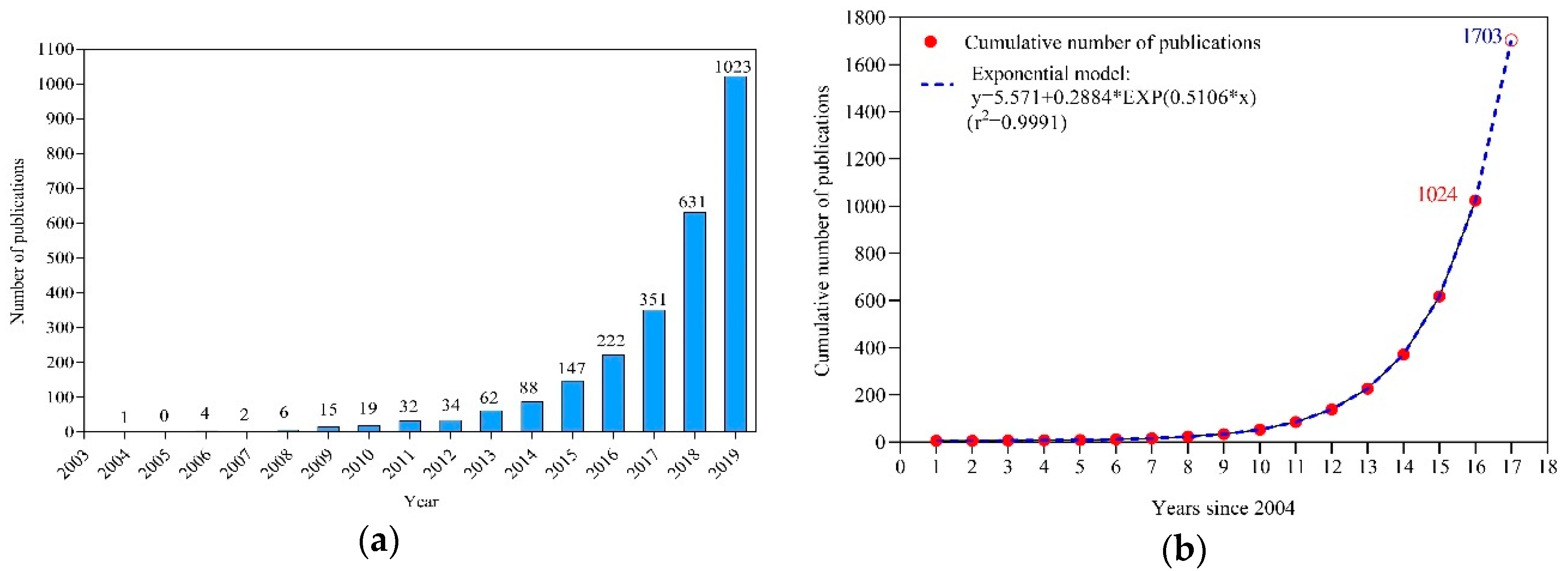
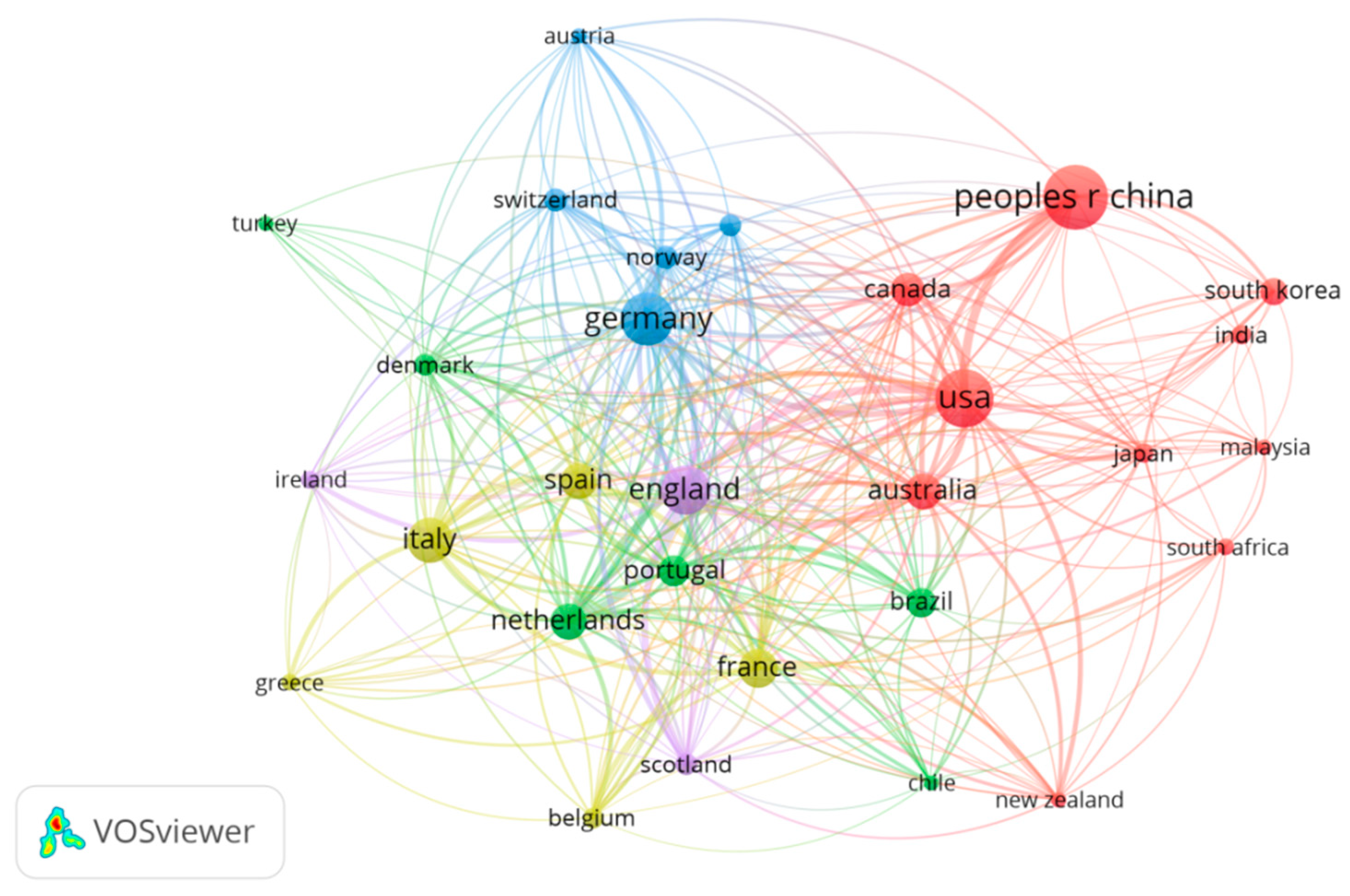
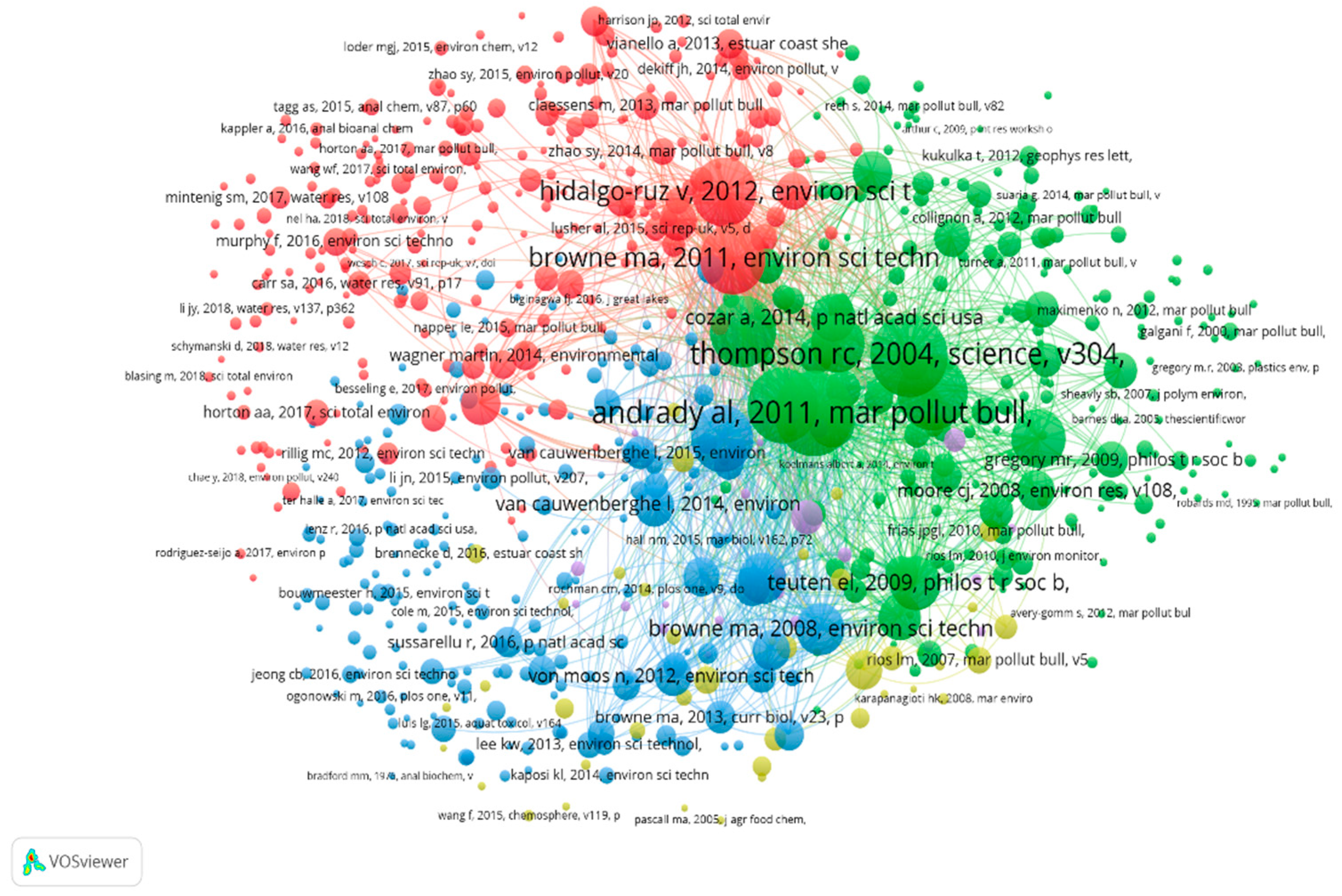
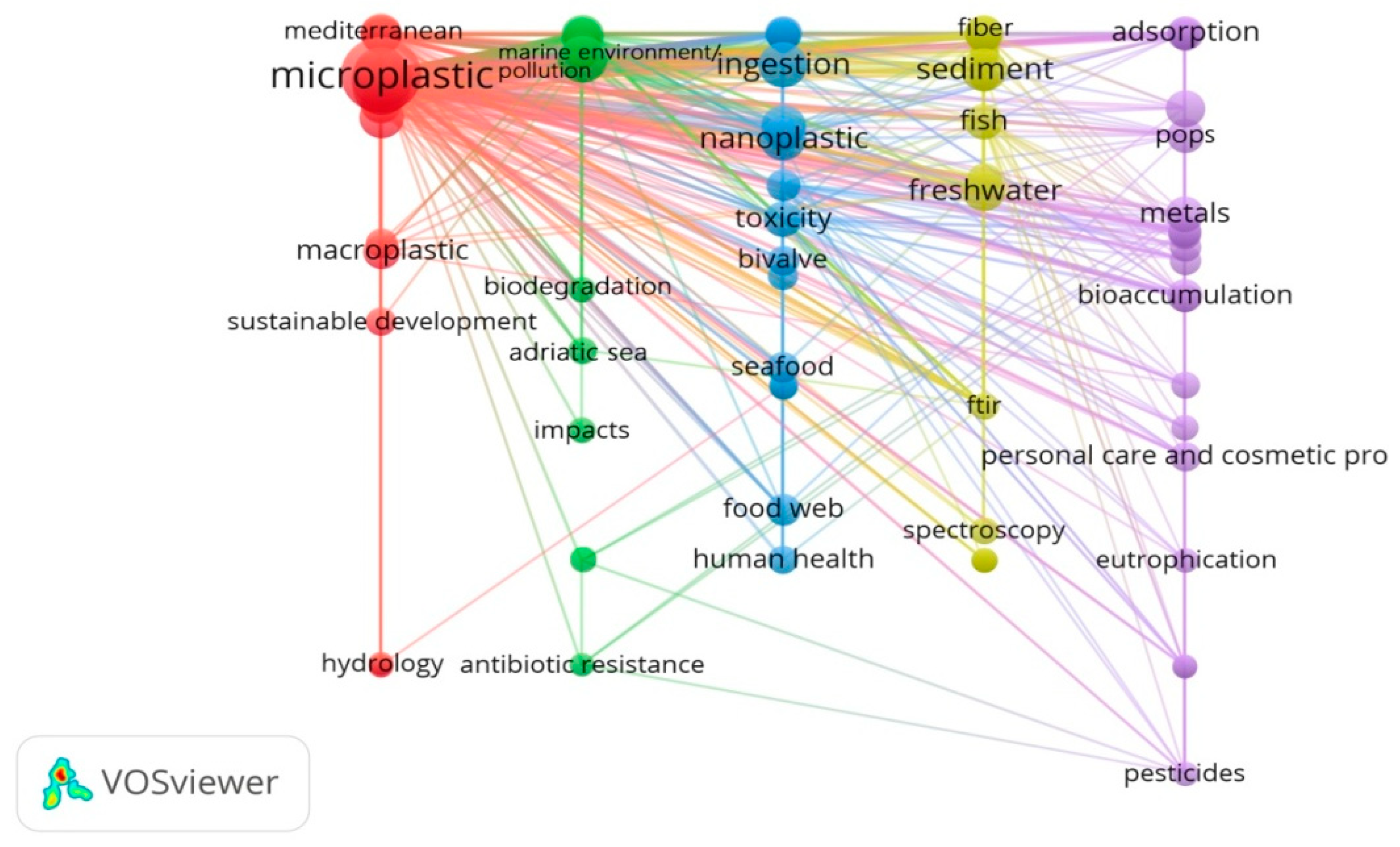
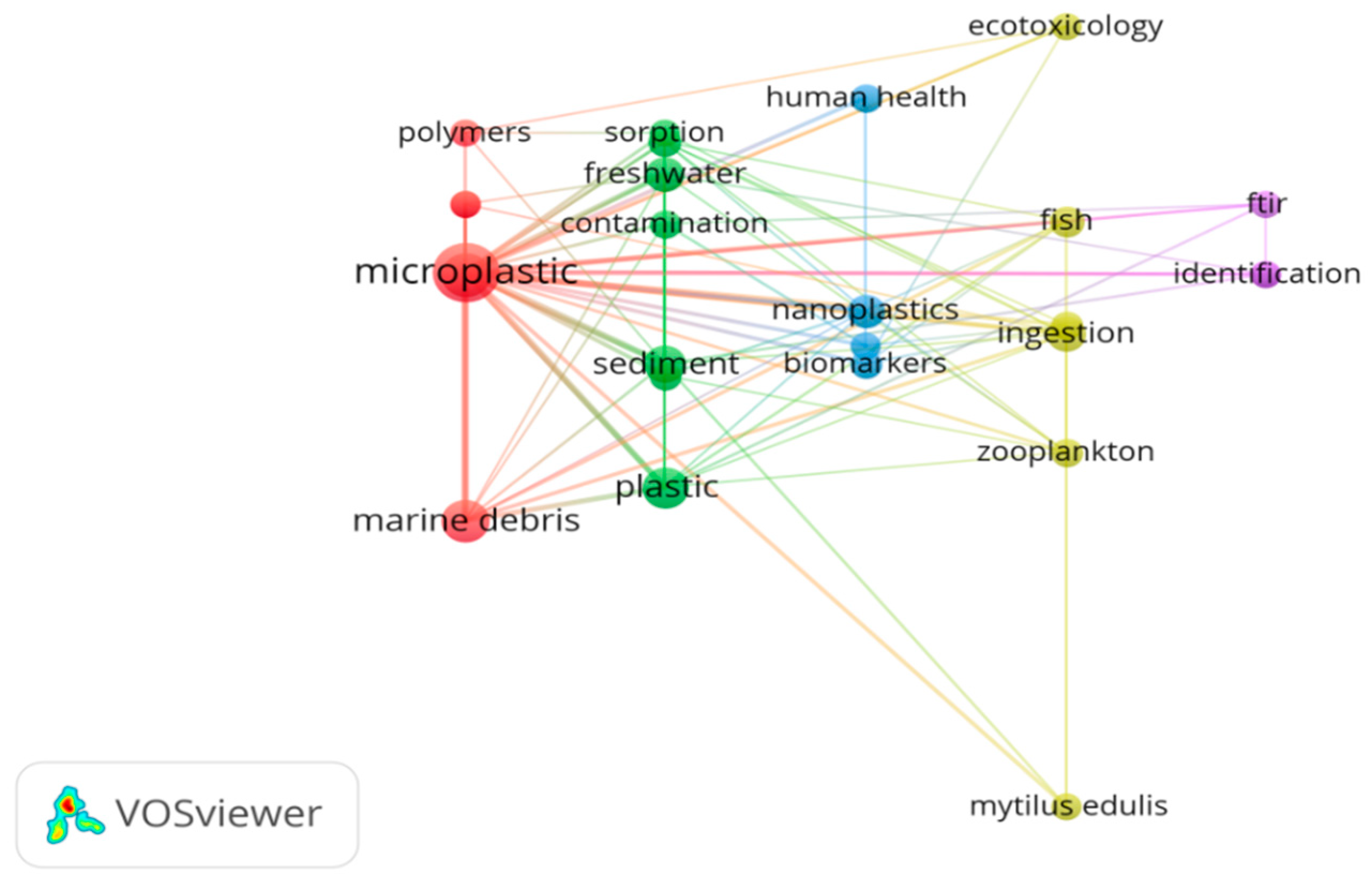
| Rank | Country | NSC 1 | TNP (R) 2 | STC (R) 3 | NSCR 4 | ≥100 5 | ≥50 6 |
|---|---|---|---|---|---|---|---|
| 1 | England | 23,182 | 282 (4) | 25,376 (2) | 91.3% | 60 | 101 |
| 2 | USA | 23,166 | 381 (2) | 25,472 (1) | 90.9% | 62 | 107 |
| 3 | Germany | 11,187 | 317 (3) | 127,28 (3) | 87.9% | 37 | 76 |
| 4 | France | 10,015 | 179 (6) | 107,83 (4) | 92.9% | 29 | 51 |
| 5 | Netherlands | 8369 | 157 (8) | 9096 (6) | 92.0% | 30 | 52 |
| 6 | Australia | 8001 | 155 (9) | 8496 (7) | 94.2% | 21 | 36 |
| 7 | China | 7491 | 459 (1) | 10,315 (5) | 72.6% | 19 | 54 |
| 8 | Canada | 6050 | 129 (10) | 6393 (8) | 94.6% | 17 | 28 |
| 9 | Spain | 5084 | 159 (7) | 5504 (9) | 92.4% | 13 | 27 |
| 10 | Italy | 4703 | 230 (5) | 5530 (10) | 85.0% | 15 | 28 |
| Rank | Author | Organization | Country | NSC | TNP | STC | NEHC 1 |
|---|---|---|---|---|---|---|---|
| 1 | Thompson, R.C. | University of Plymouth | England | 11,371 | 48 | 11,617 | 24 |
| 2 | Galloway, T.S. | University of Exeter | England | 6616 | 31 | 6739 | 18 |
| 3 | Galgani, F. | Ifremer 2 | France | 4038 | 28 | 4110 | 10 |
| 4 | Cole, M. | University of Exeter | England | 3100 | 20 | 3178 | 11 |
| 5 | Koelmans, A.A. | Wageningen University | Netherlands | 2988 | 39 | 3173 | 12 |
| 6 | Thiel, M. | Universidad Catolica del Norte | Chile | 2570 | 18 | 2612 | 5 |
| 7 | Rochman, C.M. | University of Toronto | Canada | 1654 | 24 | 1696 | 5 |
| 8 | Shim, W.J. | KIOST 3 | SouthKorea | 1629 | 33 | 1767 | 5 |
| 9 | Shi, H.H. | East China Normal University | China | 1615 | 36 | 1761 | 18 |
| 10 | Costa, M.F. | Federal University of Pernambuco | Brazil | 1277 | 20 | 1347 | 1 |
| Rank | Journal | TNP | STC(R) | NSC(R) | NSCR | IF | Categories (Quartile) |
|---|---|---|---|---|---|---|---|
| 1 | Mar Pollut Bull | 536 | 22,572(1) | 18,544(1) | 82.2% | 3.782 | Environmental Sciences (Q2); Marine and Freshwater Biology (Q1) |
| 2 | Environ Pollut | 327 | 14,456(3) | 12,711(3) | 87.9% | 5.714 | Environmental Sciences (Q1) |
| 3 | Sci Total Environ | 206 | 6082(4) | 5534(4) | 91.0% | 5.589 | Environmental Sciences (Q1) |
| 4 | Environ Sci Technol | 172 | 14,466(2) | 13,580(2) | 93.9% | 7.149 | Environmental Sciences (Q1) |
| 5 | Chemosphere | 90 | 2139(9) | 2036(9) | 95.2% | 5.108 | Environmental Sciences (Q1) |
| 6 | Environ Sci Pollut R | 63 | 867(11) | 835(11) | 96.3% | 2.914 | Environmental Sciences (Q2) |
| 7 | Sci Rep-UK | 63 | 3134(5) | 3071(5) | 98.0% | 4.011 | Multidisciplinary Sciences (Q1) |
| 8 | Water Res | 49 | 2583(6) | 2424(7) | 93.8% | 7.913 | Environmental Sciences (Q1); Water resources (Q1) |
| 9 | Front Mar Sci | 31 | 435(14) | 425(14) | 97.7% | 3.086 | Marine and Freshwater Biology (Q1) |
| 10 | Mar Environ Res | 29 | 2467(7) | 2431(6) | 98.5% | 3.445 | Environmental Sciences (Q2); Marine and Freshwater Biology (Q1) |
| 11 | Trac-Trend Anal Chem | 29 | 563(13) | 551(13) | 97.9% | 8.428 | Chemistry, Analytical (Q1) |
| 12 | Analmethods-UK | 28 | 749(12) | 739(12) | 98.7% | 2.378 | Chemistry, Analytical (Q2) |
| 13 | Environ Toxicol Chem | 28 | 1127(10) | 1094(10) | 97.0% | 3.421 | Environmental Sciences (Q2); Toxicology(Q2) |
| 14 | PlosOne | 25 | 2430(8) | 2399(8) | 98.7% | 2.776 | Multidisciplinary Science(Q2) |
| 15 | Ecotox Environ Safe | 21 | 304(15) | 298(15) | 98.0% | 4.527 | Environmental Sciences (Q1); Toxicology(Q1) |
© 2020 by the authors. Licensee MDPI, Basel, Switzerland. This article is an open access article distributed under the terms and conditions of the Creative Commons Attribution (CC BY) license (http://creativecommons.org/licenses/by/4.0/).
Share and Cite
Qin, F.; Du, J.; Gao, J.; Liu, G.; Song, Y.; Yang, A.; Wang, H.; Ding, Y.; Wang, Q. Bibliometric Profile of Global Microplastics Research from 2004 to 2019. Int. J. Environ. Res. Public Health 2020, 17, 5639. https://doi.org/10.3390/ijerph17165639
Qin F, Du J, Gao J, Liu G, Song Y, Yang A, Wang H, Ding Y, Wang Q. Bibliometric Profile of Global Microplastics Research from 2004 to 2019. International Journal of Environmental Research and Public Health. 2020; 17(16):5639. https://doi.org/10.3390/ijerph17165639
Chicago/Turabian StyleQin, Fen, Jing Du, Jian Gao, Guiying Liu, Yonggang Song, Aifu Yang, Hong Wang, Yuan Ding, and Qian Wang. 2020. "Bibliometric Profile of Global Microplastics Research from 2004 to 2019" International Journal of Environmental Research and Public Health 17, no. 16: 5639. https://doi.org/10.3390/ijerph17165639
APA StyleQin, F., Du, J., Gao, J., Liu, G., Song, Y., Yang, A., Wang, H., Ding, Y., & Wang, Q. (2020). Bibliometric Profile of Global Microplastics Research from 2004 to 2019. International Journal of Environmental Research and Public Health, 17(16), 5639. https://doi.org/10.3390/ijerph17165639




